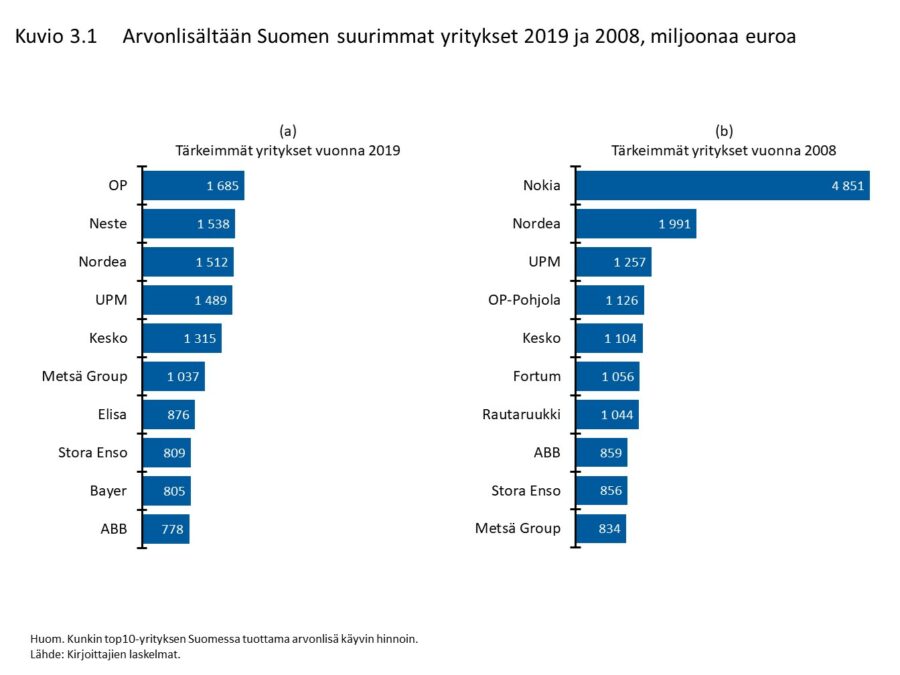
In 2019, there were three companies operating in Finland that generated more than EUR 1.5 billion in value added. According to a study published by ETLA today on the GDP impacts of large companies, the banking group OP took first place, Neste came second, and Nordea Finland took third place. The following positions were dominated by more than EUR 1 billion in value added by UPM, Kesko, and Metsä Group. Relative to the size of the economy, there are quite large companies operating in Finland, and they play a significant role as producers of GDP. However, the importance of the largest companies as employers has decreased, as has the number of their employees in Finland.
The ten largest value added groups in Finland form a diverse group of companies. Among the top 10 companies are companies operating in the industrial, service, and financial sectors. This variety is also reflected in the ownership structure, i.e. foreign-owned companies are also included.
According to the study published by ETLA today, The Role of the Largest Companies in the Finnish Economy (ETLA Report 109), in 2019 there were three companies operating in Finland that generated more than EUR 1.5 billion in value added. The banking group OP, which generated nearly EUR 1.7 billion in value added, clearly took first place. In second place was Neste (EUR 1.54 billion), and in third place was Nordea Finland (EUR 1.51 billion). UPM, Kesko, and Metsä Group reached the following positions with more than EUR 1 billion in value added. In addition, Elisa, Stora Enso, Bayer, and ABB were among the ten largest companies.
ETLA has previously published a similar study that examined the ten most important companies in Finland in 2008 and 2013. Some changes on the list were now observed. Seven of the top companies in 2008 were also included in the top 10 in 2019. The most visible of the changes is the fall of Nokia, which had previously been at the forefront, among the companies generating the most value added.
– Compared to 2008, Neste, Elisa and Bayer have reached the top 10 list as new companies. Nokia’s fall from the top 10 is noteworthy, as in 2008 Nokia was the company with largest value added. OP, which has now taken first place, was fourth in 2008. However, the number of companies with the highest added value varies somewhat, says Research Director Jyrki Ali-Yrkkö from ETLA.
According to Ali-Yrkkö, the young gaming company Supercell also rose to the list of the largest companies in 2015, but in 2019 it no longer reached the top 10 companies. Instead, German-owned Bayer moved up on the list for the first time.
In relation to the size of the economy, the top 10 companies play a very significant role as producers of Finland’s gross domestic product. In 2019, they generated 5.7 per cent of Finland’s GDP. The combined share of GDP is roughly at the same level as in 2008, i.e .their value added in Finland has grown at the same pace as in the rest of the economy.
The GDP shares calculated by ETLA do not include the multiplier effects generated by companies’ value chains, which vary by industry and company. According to the results, particularly large multiplier effects occur in the forestry industry especially.
Despite the increase in value added, the number of employees in the top 10 companies in Finland has decreased. From 2008 to 2019, the number of employees has decreased by approximately 20 per cent, although the decrease has not been continuous. The reductions are mainly between 2008 and 2015, after which the total employment of companies in Finland has increased slightly.
– Thus, although the top 10 companies have slightly increased their personnel in Finland in recent years, their share of employment in the entirety of private sector has continued to decline. In 2019, the ten companies with largest value added employed less than four per cent of the total employed by all companies, while the corresponding share in 2008 reached about five per cent,” ETLA’s Ali-Yrkkö comments.
The ten largest companies in 2019 employed nearly 63,000 people in Finland (cf. 79,000 people in 2008). However, according to Ali-Yrkkö, the aggregate figures hide the fact that among the largest companies there are also some companies that have clearly increased their staff, such as Bayer and Elisa.
The research has been funded by Helsingin Pörssiklubin säätiö and Business Finland.
